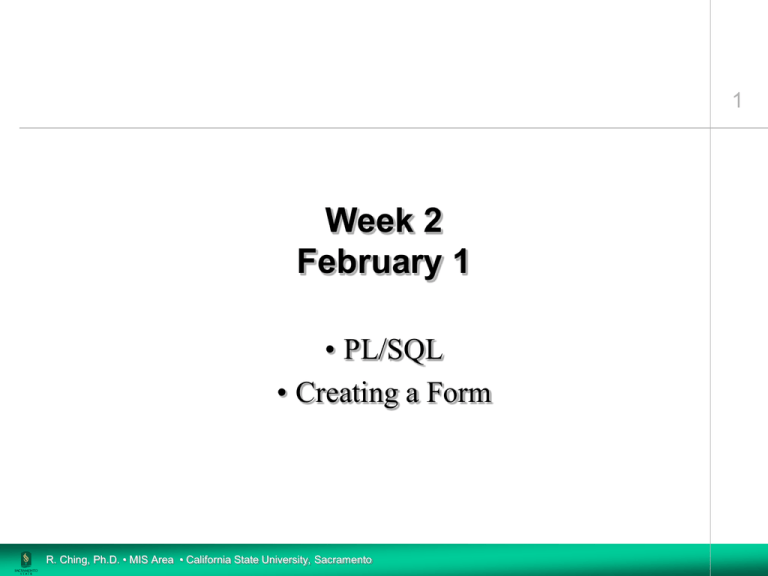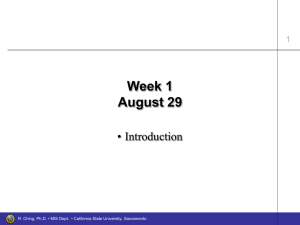Week 2 February 1 • PL/SQL • Creating a Form
advertisement

1 Week 2 February 1 • PL/SQL • Creating a Form R. Ching, Ph.D. • MIS Area • California State University, Sacramento Coding Standards 2 • Element names (functions, objects, variables, etc.): 30character maximum length • Uppercase letters for keywords • Lowercase letters for user-defined elements • 80 characters per line – One command per line • Comments – Header comments: /* comment */ – Inline comments: -- comment • Prefix object names R. Ching, Ph.D. • MIS Area • California State University, Sacramento PL/SQL Processing Language/SQL • Procedural processing language for various Oracle tools: – Forms – Reports – Graphics • Character set – Alphabetic, numeric and special characters – Arithmetic and relational operators – Others (;, ., :=, | |, --, /* */) R. Ching, Ph.D. • MIS Area • California State University, Sacramento 3 PL/SQL Block 4 Declaration Section Declares variables and constants (optional). Executable Section Procedural programming Exception Section R. Ching, Ph.D. • MIS Area • California State University, Sacramento Defines the exception handlers invoked for both predefined and user-defined exceptions (optional). PL/SQL Block 5 Declare section Executable section Exception section R. Ching, Ph.D. • MIS Area • California State University, Sacramento PL/SQL Declaration Section • Declare variable and constant names and types • Data types – Character (varchar2) – Numeric – Date – Boolean R. Ching, Ph.D. • MIS Area • California State University, Sacramento 6 Variable and Constant Declaration 7 • Defines the existence of all variables used in the procedure ... declare variable-name data-type; constant-name := value; – For example... declare Data types line_count number; product_request varchar2(10); max_count := 20; Constant R. Ching, Ph.D. • MIS Area • California State University, Sacramento For Example... 8 declare product_request varchar2(3); product_descrip varchar(30); Query assigned to “product” price real; cursor product is select product_description, product_msrp from products where manufacturer_code = product_request; ... begin; open product; loop fetch product into product_descrip, price; ... Order of variables must match the order in the select close product; R. Ching, Ph.D. • MIS Area • California State University, Sacramento Executable Section 9 • Types of statements – Assignment – Flow-of-control – SQL – Cursor • All statements must be terminated by a semi-colon (;) R. Ching, Ph.D. • MIS Area • California State University, Sacramento Exception Section 10 • Instructs PL/SQL how to handle particular exceptions exception when exception-name then PL/SQL statements; when exception-name then PL/SQL statements; end; R. Ching, Ph.D. • MIS Area • California State University, Sacramento Exception Names 11 • Predefined - Defined in Oracle – DUP_VAL_ON_INDEX (duplicate value on a unique index) – INVALID_NUMBER – NO_DATA_FOUND (no rows returned) – TOO_MANY_ROWS (multiple rows returned) – VALUE_ERROR • User-defined - Defined in the declarations as an exception (data type). R. Ching, Ph.D. • MIS Area • California State University, Sacramento Oracle Developer 12 • Forms (interactive) – Presenting information and entering data online • Reports (reporting) – Page-oriented display of information • Graphics (charts) – Graphic representation of data R. Ching, Ph.D. • MIS Area • California State University, Sacramento 13 R. Ching, Ph.D. • MIS Area • California State University, Sacramento Forms Designer 14 • Four major components – Object Navigator – Layout editor – Property palette (sheet) – PL/SQL editor R. Ching, Ph.D. • MIS Area • California State University, Sacramento Object Navigator 15 Forms module with various objects Modules R. Ching, Ph.D. • MIS Area • California State University, Sacramento Modules: • Forms • Menu • Libraries • Built-in Packages • Database Objects Menus 16 Toolbar Object type Hierarchy Specifies the order in which objects and items are executed R. Ching, Ph.D. • MIS Area • California State University, Sacramento Window and Canvas Objects 17 Window Canvas-View Canvas-View Four types of canvas-views: Content, Stacked, Horizontal Toolbar, and Vertical Toolbar Interface Item Boilerplate objects (lines, images, boxes, etc.) R. Ching, Ph.D. • MIS Area • California State University, Sacramento Window-Canvas-Block-Items Relationship 18 Menu object Items PL/SQL Block Canvas-View Window R. Ching, Ph.D. • MIS Area • California State University, Sacramento Layout Editor 19 Tool bar Rulers Tool palette Layout work area R. Ching, Ph.D. • MIS Area • California State University, Sacramento Property Palette Set an object’s attributes Properties of the canvas R. Ching, Ph.D. • MIS Area • California State University, Sacramento 20 Triggers 21 Trigger R. Ching, Ph.D. • MIS Area • California State University, Sacramento PL/SQL Editor 22 Trigger PL/SQL code List of triggers R. Ching, Ph.D. • MIS Area • California State University, Sacramento Inheriting Properties 23 Stereos to Go! Enter Exit Stereos to Go! View Report Graph Exit Class Properties R. Ching, Ph.D. • MIS Area • California State University, Sacramento Creating a Property Class 24 • Create a Property Class object in the parent module • Add the property and its values • Select the object in the child – Under Subclass Information, specify the property class R. Ching, Ph.D. • MIS Area • California State University, Sacramento Create the Property Class in the Parent 25 R. Ching, Ph.D. • MIS Area • California State University, Sacramento Add the Properties to the Class 26 Added to the class R. Ching, Ph.D. • MIS Area • California State University, Sacramento Inherit the Property Class in the Child 27 Select the object and its Property Palette Select Subclass Information Specify the object or property class name and its form module Property class Parent module R. Ching, Ph.D. • MIS Area • California State University, Sacramento Menus Menus 28 Menu items File Menu R. Ching, Ph.D. • MIS Area • California State University, Sacramento Menu Module 29 Menu module Menu object Menu items Five Simple Steps: Create the menu module Add the menu objects Add the menu items to the menu objects Program the items in PL/SQL Attach the menu module to the form module R. Ching, Ph.D. • MIS Area • California State University, Sacramento Why Multiple Forms? 30 • Build more functional units (forms) – Design the form to support a narrow scope of functions – Reduce the complexity of a single form • Reduce the time to develop and implement an application • Enhance maintainability of the application (plug-and-play!) • Promotes reusability or cloning R. Ching, Ph.D. • MIS Area • California State University, Sacramento Calling and Called Forms 31 • The calling form module transfers control (calls, opens) to the called form Calling Called CALL_FORM(form-module-name,display,switch-menu) – Calling form remains present behind the called form – Called module assumes the calling module’s menu module R. Ching, Ph.D. • MIS Area • California State University, Sacramento Calling and Called Forms 32 • Upon exit of the called form, control returns to the calling formmodule EXIT_FORM R. Ching, Ph.D. • MIS Area • California State University, Sacramento Calling Called Calling a Form Module 33 • Create or select an item (i.e., push button) on the canvas or in the menu module • Program the item in the PL/SQL Editor – Select a trigger that will activate the procedure – Enter the CALL_FORM statement – Compile the code • Test the form module R. Ching, Ph.D. • MIS Area • California State University, Sacramento In the PL/SQL Editor 34 Form module name Causes Oracle Forms to keep the default menu application of the calling form active for the called form. (REPLACE) Causes Oracle Forms to clear the calling form from the screen before drawing the called form. HIDE is the default parameter. (NO_HIDE) R. Ching, Ph.D. • MIS Area • California State University, Sacramento NEW_FORM 35 • NEW_FORM closes the calling form Greeting Screen NEW_FORM Menu Main Menu EXIT_FORM CALL_FORM EXIT_FORM Query R. Ching, Ph.D. • MIS Area • California State University, Sacramento 36 R. Ching, Ph.D. • MIS Area • California State University, Sacramento



